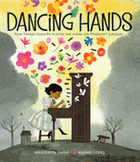
"When Teresa was a little girl in Venezuela, Mamá sang lullabies while Papá showed Teresita how to let her happy hands dance across all the beautiful dark and light keys of a piano." The opening line from Dancing Hands sets both the stage and the mood for this picture-book portrait of a great but largely forgotten performer in her youthful prime.
By age six, Teresa Carreño (1853-1917) could compose music; at seven she performed at a cathedral. When she was eight, war broke out in Venezuela, so Carreño's father took the family to New York City to escape the violence and begin their lives again. But the United States wasn't a nation at peace either--the Civil War was raging. Still, Carreño and her family were safe in New York, and their apartment had a piano. Soon Carreño, who was becoming known as "the Piano Girl," was playing with orchestras and invited to perform near and far, most dauntingly and climactically for President Abraham Lincoln and his family at the White House.
Although Dancing Hands is a story of triumph, Margarita Engle doesn't gloss over the darker circumstances--historical and personal--that surrounded Carreño's artistic rise. Rafael López's digitally assembled mixed-media art is like a reflection of Carreño's emotional topography: he adapts his palette to suit her state of mind. An author's note offers a brief look at Carreño's adult life, which was distinguished by performing, composing, singing and a scandal too delicious not to report here: she returned to her native Venezuela only once because its citizens were appalled that she had married and divorced three times before she settled down with her fourth and final husband. --Nell Beram, freelance writer and YA author

